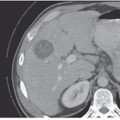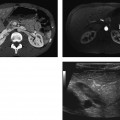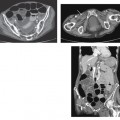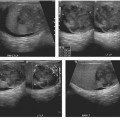CASE 138 A 76-year-old woman presents with lower abdominal pain, weight loss, and changes in bowel habits. Fig. 138.1 (A,B) Axial MR T2-weighted images demonstrate a large, cystic mass centered in the pelvis with multiple, small, solid papillary projections present along the walls of the lesion. Axial magnetic resonance (MR) T2-weighted images (Fig. 138.1) demonstrate a large, cystic mass centered in the pelvis with multiple, small, solid papillary projections present along the walls of the lesion. Ovarian mucinous cystoadenocarcinoma Ovarian cancer represents the deadliest gynecologic malignancy and the fifth leading cause of death worldwide from cancer in the female population; most of the cases (90%) are sporadic and occur in postmenopausal women (more often in their 6th to 7th decades), with a small percentage (1–5%) described in younger patients with a family history of ovarian cancer. This neoplasm is extremely insidious, as it causes minimal or no symptoms in its early stages; thus, the diagnosis is often delayed. Ovarian tumors may be grouped according to their cellular origin into three major categories: Among malignant neoplasms, the epithelial type is the most common (85% of cases) in the postmenopausal population; conversely, malignant germ cell tumors represent more than two thirds of ovarian malignancies affecting younger patients (< 20 years of age). Symptoms are usually minimal or nonspecific. In advanced stages, patients may experience abdominal pain, weight loss, changes in bowel habits, abdominal distention, or bowel obstruction. Cancer antigen 125 (CA 125) may be either increased or within normal limits (> 50% of cases); 85% of patients younger than 50 years with elevated CA 125 have benign disease, such as pelvic inflammatory disease, endometriosis, fibroids, or early pregnancy.
Clinical Presentation

Radiologic Findings
Diagnosis
Differential Diagnosis
Discussion
Background
Clinical Findings
Complications
Stay updated, free articles. Join our Telegram channel

Full access? Get Clinical Tree








